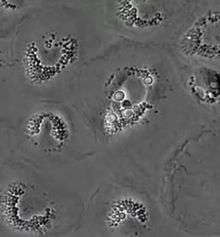Vomocytosis

Vomocytosis is the cellular process by which live organisms that have previously been engulfed by a white blood cell are expelled without being destroyed. Vomocytosis was first reported in 2006[1][2] by two groups, working simultaneously in the UK and the USA, based on time-lapse microscopy footage characterising the interaction between macrophages and the human fungal pathogen Cryptococcus neoformans. Subsequently, this process has also been seen with other fungal pathogens such as Candida albicans[3] and Candida krusei.[4] It has also been speculated[5] that the process may be related to the expulsion of bacterial pathogens such as Mycobacterium marinum[6] from host cells. Vomocytosis has been observed in phagocytic cells from mice, humans and birds,[7] as well as being directly observed in zebrafish[8] and indirectly detected (via flow cytometry) in mice.[9]
The mechanism of vomocytosis remains unclear although it is known to be influenced by inflammatory signals[10] and rearrangements of the actin cytoskeleton[11] within the host cell. Different morphologies[12] of vomocytosis have been documented and it is possible that the underlying cellular mechanism may vary between them.
References
- ↑ Ma, H; Croudace, JE; Lammas, DA; May, RC (7 November 2006). "Expulsion of live pathogenic yeast by macrophages.". Current Biology. 16 (21): 2156–60. doi:10.1016/j.cub.2006.09.032. PMID 17084701.
- ↑ Alvarez, M; Casadevall, A (7 November 2006). "Phagosome extrusion and host-cell survival after Cryptococcus neoformans phagocytosis by macrophages.". Current Biology. 16 (21): 2161–5. doi:10.1016/j.cub.2006.09.061. PMID 17084702.
- ↑ Bain, JM; Lewis, LE; Okai, B; Quinn, J; Gow, NA; Erwig, LP (September 2012). "Non-lytic expulsion/exocytosis of Candida albicans from macrophages.". Fungal Genetics and Biology. 49 (9): 677–8. doi:10.1016/j.fgb.2012.01.008. PMID 22326419.
- ↑ García-Rodas, R; González-Camacho, F; Rodríguez-Tudela, JL; Cuenca-Estrella, M; Zaragoza, O (June 2011). "The interaction between Candida krusei and murine macrophages results in multiple outcomes, including intracellular survival and escape from killing.". Infection and Immunity. 79 (6): 2136–44. doi:10.1128/iai.00044-11. PMID 21422181.
- ↑ Johnston, SA; May, RC (March 2013). "Cryptococcus interactions with macrophages: evasion and manipulation of the phagosome by a fungal pathogen.". Cellular Microbiology. 15 (3): 403–11. doi:10.1111/cmi.12067. PMID 23127124.
- ↑ Hagedorn, M; Rohde, KH; Russell, DG; Soldati, T (27 March 2009). "Infection by tubercular mycobacteria is spread by nonlytic ejection from their amoeba hosts.". Science. 323 (5922): 1729–33. doi:10.1126/science.1169381. PMID 19325115.
- ↑ Johnston, SA; Voelz, K; May, RC (17 February 2016). "Cryptococcus neoformans Thermotolerance to Avian Body Temperature Is Sufficient For Extracellular Growth But Not Intracellular Survival In Macrophages.". Scientific Reports. 6: 20977. doi:10.1038/srep20977. PMC 4756366
 . PMID 26883088.
. PMID 26883088. - ↑ Bojarczuk, A; Miller, KA; Hotham, R; Lewis, A; Ogryzko, NV; Kamuyango, AA; Frost, H; Gibson, RH; Stillman, E; May, RC; Renshaw, SA; Johnston, SA (18 February 2016). "Cryptococcus neoformans Intracellular Proliferation and Capsule Size Determines Early Macrophage Control of Infection.". Scientific Reports. 6: 21489. doi:10.1038/srep21489. PMC 4757829
 . PMID 26887656.
. PMID 26887656. - ↑ Nicola, AM; Robertson, EJ; Albuquerque, P; Derengowski Lda, S; Casadevall, A (2011). "Nonlytic exocytosis of Cryptococcus neoformans from macrophages occurs in vivo and is influenced by phagosomal pH.". mBio. 2 (4): e00167–11. doi:10.1128/mBio.00167-11. PMC 3150755
 . PMID 21828219.
. PMID 21828219. - ↑ Voelz, K; Lammas, DA; May, RC (August 2009). "Cytokine signaling regulates the outcome of intracellular macrophage parasitism by Cryptococcus neoformans.". Infection and Immunity. 77 (8): 3450–7. doi:10.1128/iai.00297-09. PMID 19487474.
- ↑ Johnston, SA; May, RC (12 August 2010). "The human fungal pathogen Cryptococcus neoformans escapes macrophages by a phagosome emptying mechanism that is inhibited by Arp2/3 complex-mediated actin polymerisation.". PLoS Pathogens. 6 (8): e1001041. doi:10.1371/journal.ppat.1001041. PMC 2920849
 . PMID 20714349.
. PMID 20714349. - ↑ Alvarez, M; Casadevall, A (16 August 2007). "Cell-to-cell spread and massive vacuole formation after Cryptococcus neoformans infection of murine macrophages.". BMC Immunology. 8: 16. doi:10.1186/1471-2172-8-16. PMID 17705844.